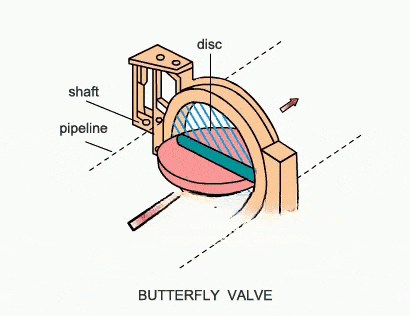A butterfly valve is a type of quarter-turn valve widely used in pipelines to regulate or isolate fluid flow.
Its name comes from the metal disc that rotates within the valve body — resembling a butterfly’s wings in motion.

Because of its compact structure, quick operation, and low cost, the butterfly valve has become one of the most popular flow-control devices across industries such as water supply, HVAC, chemical processing, food, and power generation.
Table of Contents
ToggleBasic Working Principle
The butterfly valve operates by turning a circular disc (or plate) inside the valve body.
This disc is mounted on a shaft, which connects to an actuator or hand lever outside the valve.
When the disc is parallel to the flow (fully open), fluid passes through freely.
When the disc is perpendicular to the flow (fully closed), the passage is blocked.
At intermediate angles, the valve regulates the flow rate, acting as a throttling valve.
In short, a 90-degree rotation of the handle or actuator moves the valve from fully open to fully closed.
Key Components of a Butterfly Valve
Valve Body
Houses the internal components and connects to the pipeline.
Common types include wafer, lug, and flanged bodies.
Disc (Butterfly Plate)
The main closing element that rotates to control flow.
Made of stainless steel, ductile iron, or other corrosion-resistant materials.
Stem (Shaft)
Connects the disc to the actuator or handle.
Transfers rotational force to the disc.
Seat (Sealing Ring)
Provides a tight seal between the disc edge and valve body to prevent leakage.
Usually made of rubber, PTFE, or other elastomeric materials.
Actuator or Handle
Manual butterfly valves use a lever or gearbox.
Automated versions use electric, pneumatic, or hydraulic actuators.
Operating Mechanism
Fully Open Position (0° Rotation)
The disc is aligned with the direction of flow, causing minimal obstruction and low pressure drop.
Ideal for maximum flow applications.Partially Open Position (15°–75° Rotation)
The disc is partly turned, creating an adjustable flow area.
This allows the valve to throttle or regulate flow efficiently.Fully Closed Position (90° Rotation)
The disc is perpendicular to the flow path, pressing tightly against the seat to stop flow completely.
Types of Butterfly Valves
1. Concentric Butterfly Valve
The stem passes through the center of the disc and seat.
Suitable for low-pressure, general-purpose applications.
2. Double Eccentric (High-Performance) Butterfly Valve
The stem is offset slightly from the disc centerline, reducing seat wear.
Handles higher pressures and temperatures.
3. Triple Eccentric Butterfly Valve
Adds a third offset, eliminating rubbing between the disc and seat during operation.
Used in critical applications requiring metal-to-metal sealing and zero leakage.
Advantages of Butterfly Valves
✅ Compact and lightweight — requires less installation space.
✅ Quick quarter-turn operation — easy to open or close.
✅ Cost-effective compared with gate or ball valves.
✅ Low pressure loss when fully open.
✅ Suitable for large-diameter pipelines.
Limitations
Not suitable for high-pressure throttling.
The disc remains in the flow path even when fully open, causing slight turbulence.
Elastomeric seats may not withstand very high temperatures or aggressive chemicals.
Common Applications
Butterfly valves are widely used in:
Water treatment plants
HVAC systems
Fire protection systems
Chemical and petrochemical industries
Food and beverage processing
Power plants
Conclusion
In essence, a butterfly valve works by rotating a disc inside the valve body to control fluid flow.
This simple yet effective mechanism allows quick shut-off and precise regulation with minimal space and cost.
Whether manually operated or automated, butterfly valves offer reliable performance, durability, and efficiency, making them a preferred choice for modern fluid control systems.
